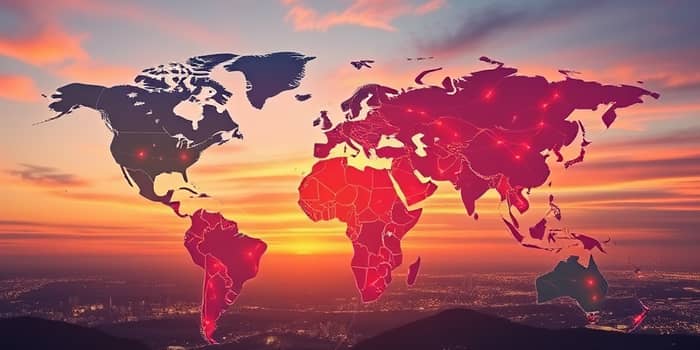
As the world emerges from the disruptions of COVID-19, economies are settling into a new rhythm. This article examines how macroeconomic indicators, sectoral shifts, and societal transformations have combined to create a landscape shaped by both challenges and opportunities.
Across regions, the global economy is adjusting to its steady but modest growth pace as stimulus measures wane and structural adjustments take hold.
Global growth forecasts have been tempered, with the IMF projecting a slowdown to 2.9% in 2025 and 2.8% in 2026. In the United States, year-ahead GDP growth is expected near 1%, reflecting a return to potential output levels. Meanwhile, the Eurozone hovers around 0.8% growth, grappling with legacy challenges from the pandemic.
Inflationary pressures have eased but remain above targets in many regions. Global inflation is predicted to fall to 2.1% next year and 2.0% in 2026, prompting central banks to signal rate cuts only in late 2025. Public debt levels have surged, with governments turning to increased spending to counteract weak private demand. Germany’s deficit nears post-reunification highs, while the U.S. calibrates fiscal expansions to avoid bond market volatility.
The pandemic accelerated shifts across primary, secondary, and tertiary sectors, leaving behind an economic terrain marked by both resilience and scarring.
Supply chains have reoriented, moving from global optimization toward regionalized supply chains for greater resilience. Businesses are diversifying suppliers, stockpiling critical inputs, and investing in technology to track inventory and logistics in real time.
Remote work, once an emergency measure, has become an integral feature of many corporate cultures. Today, hybrid models and fully remote arrangements coexist, fostering entrenched hybrid and remote work across knowledge industries.
Consumer habits have also evolved. Online shopping, contactless payments, and virtual services surged during lockdowns and have become permanent fixtures. While durable goods purchases have cooled—illustrated by a 3.8% drop in Q1 2025—they remain above long-term pre-pandemic trends, reflecting permanent shifts in consumer habits.
To support these behaviors, companies are directing capital toward digital infrastructure. Cloud services, cybersecurity, and e-commerce platforms are flourishing, benefitting from elevated investment in digital infrastructure worldwide.
Governments’ large-scale interventions have left indelible marks on economic policy frameworks. Central banks adopted aggressive asset purchases and near-zero rates, while fiscal packages—like Europe’s €1.7 trillion rescue fund—set new precedents for crisis response.
Major policy legacies include higher deficits normalized as standard tools, expanded industrial policies targeting sectors from renewables to critical minerals, and strengthened labor market supports such as extended unemployment benefits and wage supplements. Yet significant risks loom. Renewed trade tensions, including potential U.S. tariffs surging into the 25–75% range, could spark a stagflationary spiral. Commodity exporters remain vulnerable to demand swings, and lower-wage workers face lasting labor market scars from job losses during the pandemic.
This snapshot highlights how the immediate crisis phase has given way to a more predictable but still complex environment. Governments, businesses, and households alike must adapt to these evolving baselines.
A set of enduring themes defines this era, where resilience and adaptability have superseded pure efficiency as guiding principles. These lasting structural changes across sectors will shape strategies and investments for years to come.
Organizations and policymakers can seize opportunities by embracing a proactive stance focused on innovation, resilience, and inclusion. Key considerations include:
By prioritizing these strategies, stakeholders can navigate the uncertainties ahead and build on the progress made since the depths of the pandemic.
Ultimately, the post-pandemic economy is not a return to the past but a transition to a new configuration. Success will hinge on the ability to balance growth, equity, and risk management in an ever-evolving global landscape.
As we chart a course forward, evaluating data, listening to diverse voices, and remaining agile will be crucial. The lessons learned during the crisis years offer a blueprint for more resilient, inclusive, and dynamic economies—one where innovation and collaboration drive sustainable progress.
References













